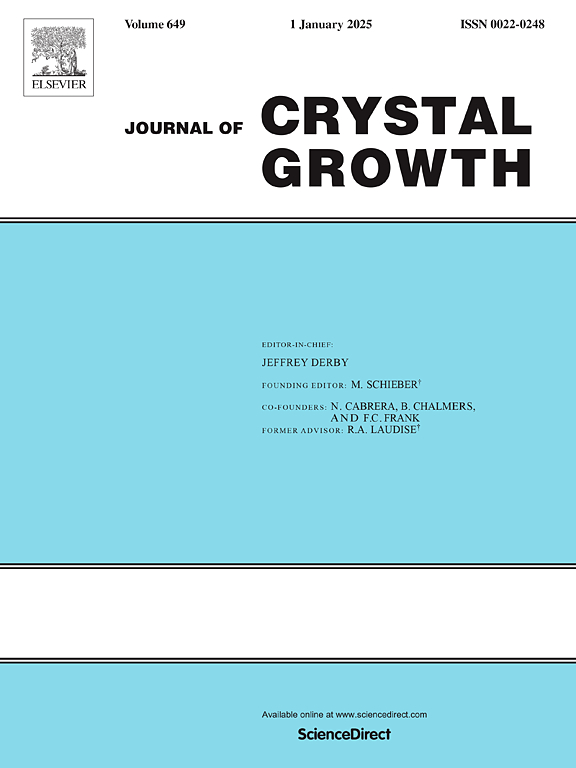Growth of hexagonal BN crystals by traveling-solvent floating zone
IF 2
4区 材料科学
Q3 CRYSTALLOGRAPHY
引用次数: 0
Abstract
Large, high-purity single-crystals of hexagonal BN (h-BN) are essential for exploiting its many desirable and interesting properties. Here, we demonstrate via X-ray tomography, X-ray diffraction and scanning electron microscopy that h-BN crystals can be grown by traveling-solvent floating-zone (TSFZ). The diameters of grown boules range from 3 – 5 mm with lengths from 2 – 10 mm. Tomography indicates variable grain sizes within the boules, with the largest having areas of 1 mm 2 mm and thickness 0.5 mm. Although the boules contain macroscale flux inclusions, the h-BN lattice itself is of high quality for samples grown under optimized conditions. The currently optimized growth procedure employs an Fe flux, moderate N pressure ( 6 bar), and a growth rate of 0.1 mm/h. Raman spectroscopy for an optimized sample gives an average linewidth of 7.7(2) cm−1 for the E intralayer mode at 1365.46(4) cm−1 and 1.0(1) cm−1 for the E interlayer shear mode at 51.78(9) cm−1. The corresponding photoluminescence spectrum shows sharp phonon-assisted free exciton peaks and minimal signal in the energy range corresponding to carbon-related defects ( = 3.9 – 4.1 eV). Our work demonstrates the viability of growing h-BN by the TSFZ technique, thereby opening a new route towards larger, high-quality crystals and advancing the state of h-BN related research.
流动溶剂浮区生长六方BN晶体
大的,高纯度的六方BN (h-BN)单晶对于开发其许多令人满意和有趣的性质是必不可少的。在这里,我们通过x射线断层扫描、x射线衍射和扫描电子显微镜证明了h-BN晶体可以通过流动溶剂漂浮区(TSFZ)生长。长成的球直径为3 - 5毫米,长度为2 - 10毫米。断层扫描显示,气泡内的晶粒大小不一,最大的气泡面积约为1mm × 2mm,厚度约为0.5 mm。虽然气泡中含有宏观通量夹杂物,但在优化条件下生长的样品中,h-BN晶格本身具有高质量。目前优化的生长过程采用铁通量,中等N2压力(PN2≈6 bar),生长速度为0.1 mm/h。优化样品的拉曼光谱显示,E2g层内模式的平均线宽为7.7(2)cm−1,为1365.46(4)cm−1,E2g层间剪切模式的平均线宽为1.0(1)cm−1,为51.78(9)cm−1。相应的光致发光光谱显示出尖锐的声子辅助自由激子峰和碳相关缺陷对应的能量范围内(E = 3.9 ~ 4.1 eV)的最小信号。我们的工作证明了用TSFZ技术生长h-BN的可行性,从而开辟了一条通往更大、高质量晶体的新途径,并推进了h-BN相关研究的状态。
本文章由计算机程序翻译,如有差异,请以英文原文为准。
求助全文
约1分钟内获得全文
求助全文
来源期刊

Journal of Crystal Growth
化学-晶体学
CiteScore
3.60
自引率
11.10%
发文量
373
审稿时长
65 days
期刊介绍:
The journal offers a common reference and publication source for workers engaged in research on the experimental and theoretical aspects of crystal growth and its applications, e.g. in devices. Experimental and theoretical contributions are published in the following fields: theory of nucleation and growth, molecular kinetics and transport phenomena, crystallization in viscous media such as polymers and glasses; crystal growth of metals, minerals, semiconductors, superconductors, magnetics, inorganic, organic and biological substances in bulk or as thin films; molecular beam epitaxy, chemical vapor deposition, growth of III-V and II-VI and other semiconductors; characterization of single crystals by physical and chemical methods; apparatus, instrumentation and techniques for crystal growth, and purification methods; multilayer heterostructures and their characterisation with an emphasis on crystal growth and epitaxial aspects of electronic materials. A special feature of the journal is the periodic inclusion of proceedings of symposia and conferences on relevant aspects of crystal growth.
 求助内容:
求助内容: 应助结果提醒方式:
应助结果提醒方式:


